How to grow strawberries from seeds?

Strawberries (or, as it is correct to call them, garden strawberries) is a rather capricious culture. But its taste characteristics justify the possible difficulties of care. And among these difficulties, one appears, perhaps the most important one - growing strawberries from seeds. Not everyone undertakes this, considering that there are many risks, and the result is unpredictable. Perhaps good theoretical training will remove fears and help to come to a positive result.
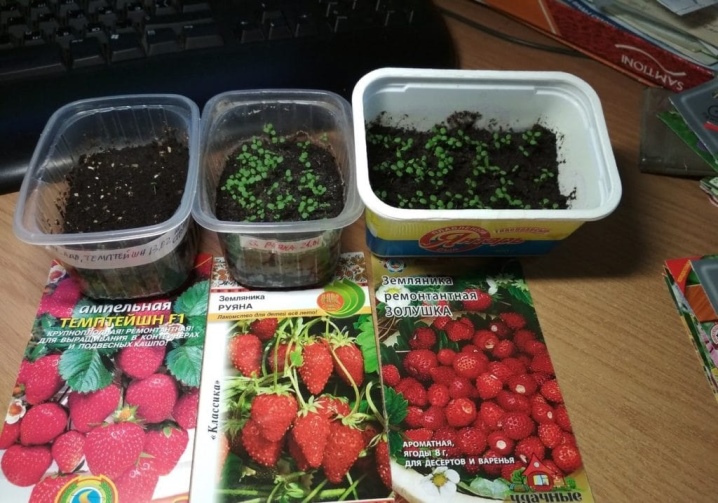
Advantages and disadvantages
The first and obvious plus is the ability not to worry about the condition of the seeds.
They are stored much longer than seedling bushes. Sprouts are more vulnerable, with the slightest changes in growing conditions or leaving they can die.
What are the other benefits of seeds:
- seeds are cheaper than seedlings;
- selection of a variety is simplified;
- you can get many bushes from one berry;
- it is easier to trace the characteristics of plant growth and its needs, knowing the specific variety.
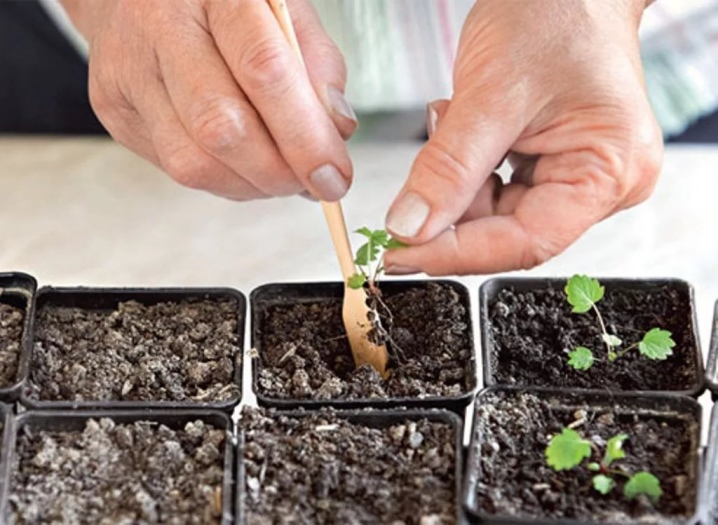
And the method has only two drawbacks: it is the laboriousness of the process, because it is not so easy to collect seeds and expel seedlings. The second disadvantage is the sensitivity of young plants to weather conditions. And also some gardeners note a high splitting of the varietal traits of strawberries, which had to be grown from seeds. This applies to both standard strawberries and remontant ones.
Indeed, such a fear may exist: the taste of the berry changes, it happens that in the direction of deterioration. This is due to the fact that strawberries are not self-fertile (more precisely, they are not self-fertile enough), therefore, for better pollination, several varieties are grown on the site at once. The seeds contain varietal genes, those that participated in pollination, so confusion can arise in the offspring.
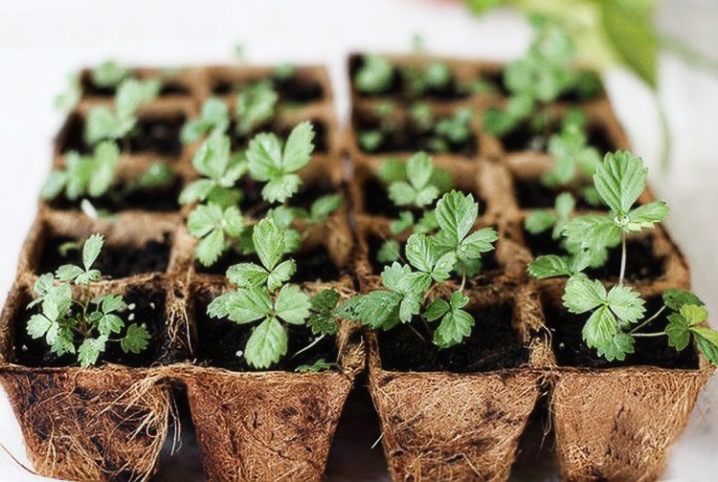
And also strawberry seedlings are dependent on the microclimate, they are very sensitive to changes in conditions. This is why growing them in an apartment is difficult.
With tomatoes and peppers, for example, this is much easier to do. And finding a good selection of strawberry seeds in specialized stores is problematic.
It seems that the difficulties are significant. But why do gardeners often hunt for seeds anyway? Because their germination rate is high, reaching 98%. And they can be stored for up to 4 years, although it may not be worth pushing storage to the deadline. Freshly harvested seeds in this sense are the most reliable, after planting on day 7-10 they sprout. With shops, everything is a little more complicated. Therefore, gardeners who buy seeds in the store, purchase them from different points, take different brands and varieties in order to increase the likelihood of successful seedlings.
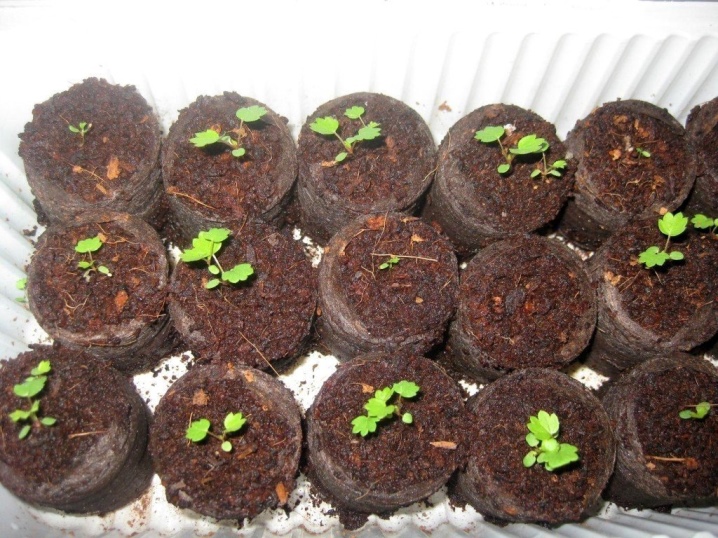
Suitable varieties
Repaired varieties give several harvests per season, but the fruits may not be as sweet and aromatic.
Hybrid varieties will produce large berries, but they will also require more fertilizers. If there is a goal to consume fresh strawberries, then it is better to turn to sweet varieties.
If, however, mainly cultivation is for blanks, then varieties with a sour berry will be required.
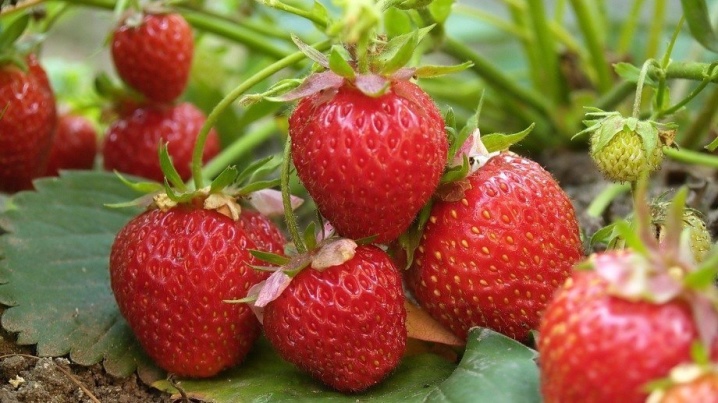
Most suitable varieties for seed propagation.
-
"Queen Elizabeth". Repaired type that bears fruit throughout the season. The berries grow large and fragrant, with a beautiful raspberry color. This is a profitable variety both for sale and for transportation from the dacha to the city - the berries fit tightly, they tolerate transportation well.
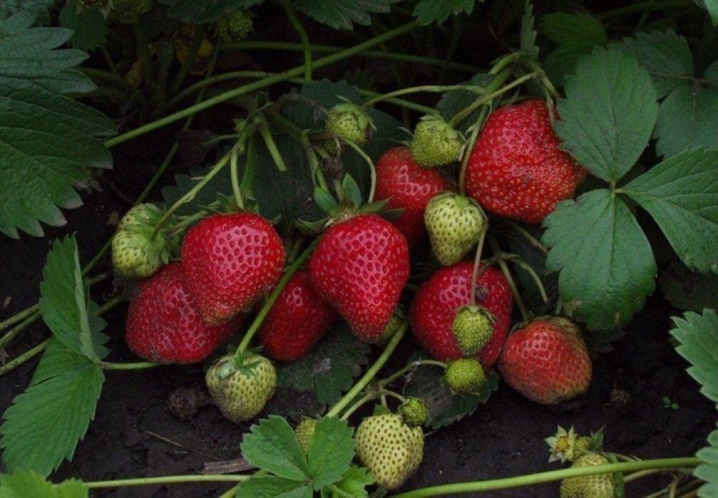
- "Gigantella"... Non-hybrid variety, will bear fruit only once a season. Large fruits, one can weigh 120g.There are no questions about taste either. Berries are stored for a long time, because they have dry skin.
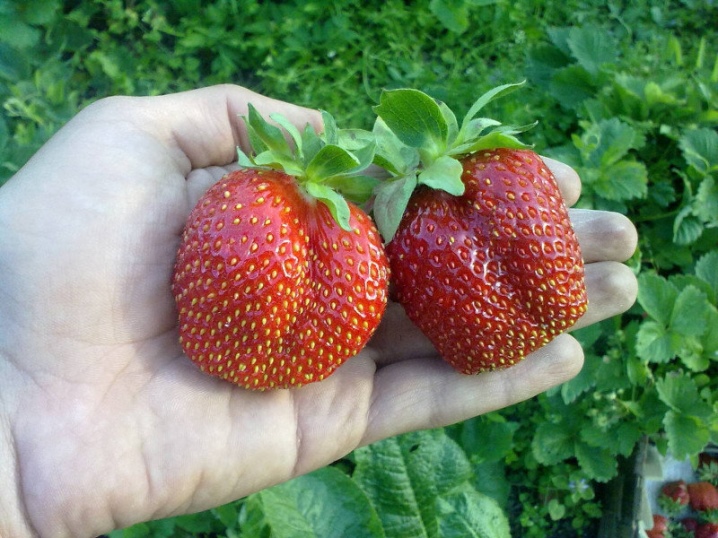
-
"Tristar"... The strawberry is large and has an attractive conical shape. At the end of summer, the variety can surprise with a second harvest. It is considered a dessert variety.
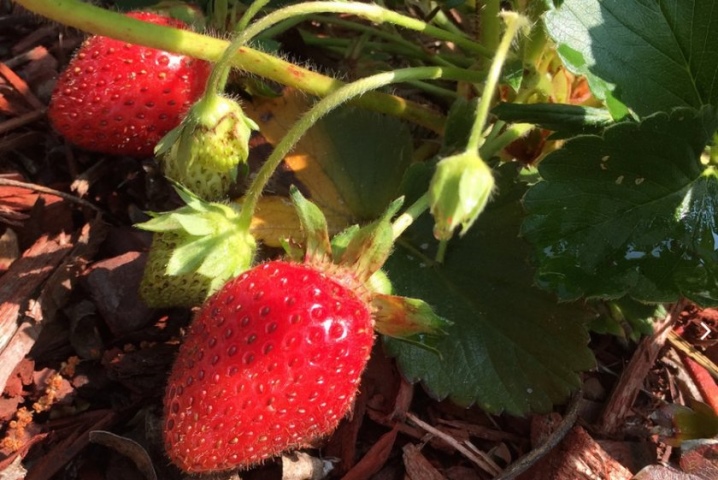
- Zephyr. Popular for its early fruiting, high yield. The plant does not require special care; it grows well in a small shade.
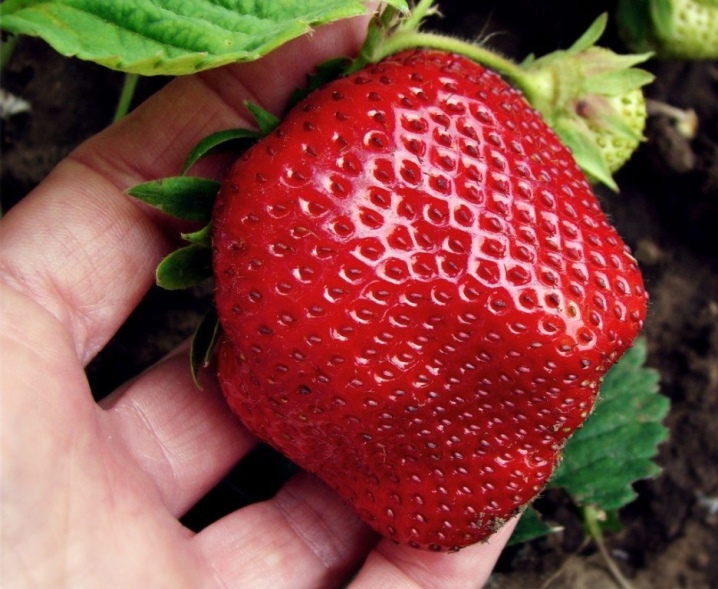
-
"Moscow delicacy F1"... A remontant type of strawberry, it produces large and sweet fruits. The harvest will be early, up to 1.5 kg of fruit can be harvested from one bush. The plant is also popular for its high aesthetics, which is why this variety is often preferred for growing in vertical beds and in pots.
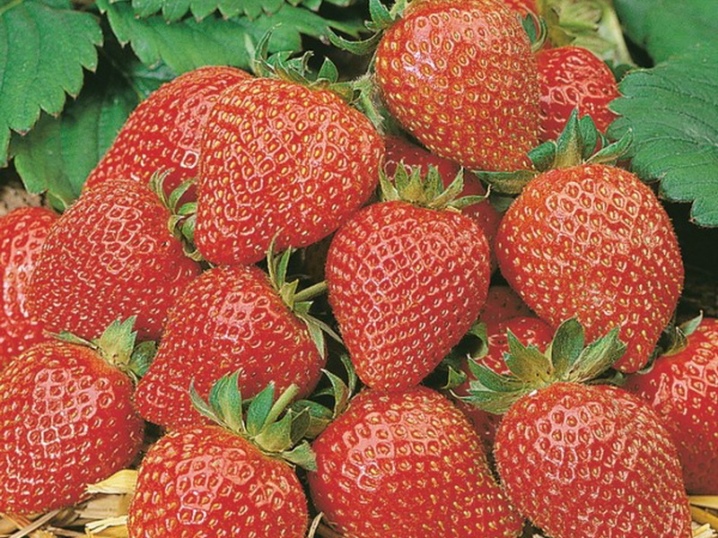
Often, gardeners collect seeds from their site, not always knowing the exact variety of the plant.
Some are skeptical about this, suggesting that the store option is more reliable.
But it is not so. It all depends on the experience of the gardener, his intuition (which many develop over the years, as they say, “the eye – diamond "), and if a person is confident in the quality of the bushes on the site, then why not collect seeds from them.
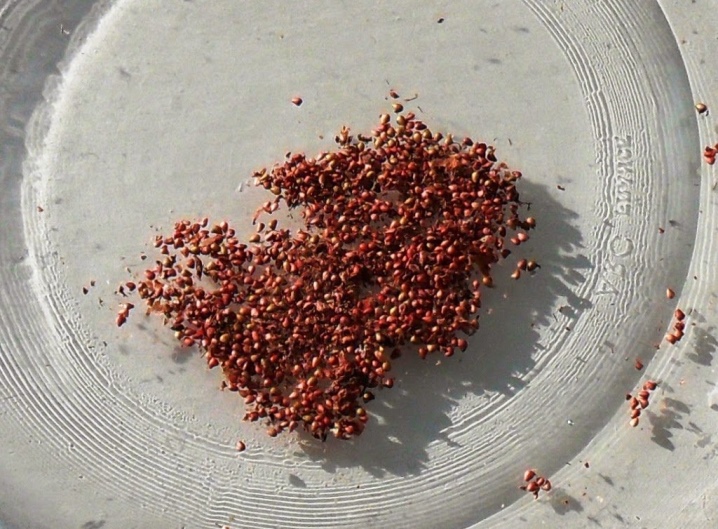
The necessary conditions
The first and foremost condition is a lot of light. It is impossible to grow strawberries without sufficient light. Of course, when natural light is not enough, you can use LED lamps with a red spectrum of radiation. Seedlings "do not like" the very bright sun, but it will not stand a long darkening either.
And also if the strawberry is damp at home, its seeds may not sprout. It is necessary to moisten the soil, but moderately stably. The seedlings should be watered with water, which is heated to about +25 degrees, no more. As for the soil, the best option would be any type of soil mixture with a slightly acidic and neutral reaction.
Sandy-clayey soil is considered the best option, only it should be rich in humus and nutrients.
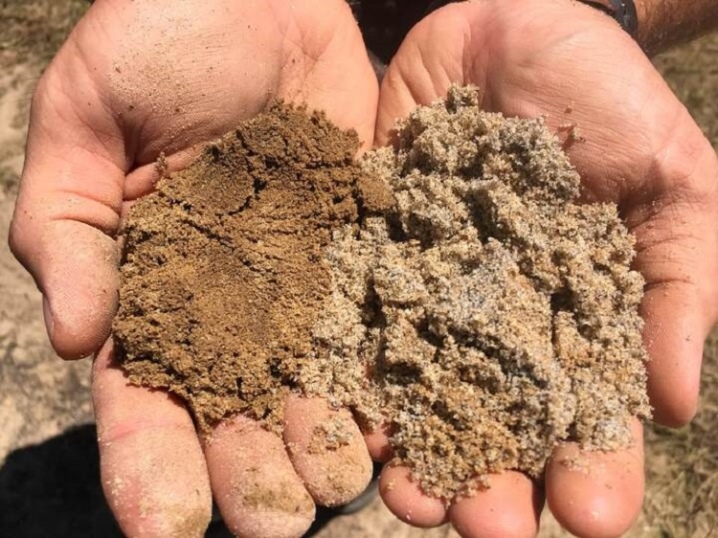
And also the most important condition for the growth of seeds will be their competent selection.... It is necessary to collect the largest berries, which are already ripe enough. You need to take a sharp knife, cut off the layer of pulp directly with the seeds, then put it on paper and let dry in the sun for 8 days. The already dried pulp will have to be rubbed with your hands, after which it will not be so difficult to isolate the seeds.

If you need to prepare a lot of seeds, you need to do this:
- there is a collection of unripe berries, which are put on a plate and ripen already in it;
- then the berries are laid out in banks, they need to be mixed from time to time;
- after about 10 days, a rather thick mass is formed from the berries, it must be rinsed with water;
- those heavy seeds that will then settle to the bottom, and need to be collected;
- the washed material is sent to the sun, lay it out on natural fabric (cotton, linen);
- storage of seeds is possible in cloth bags, temperature + 12 ... 14 degrees.
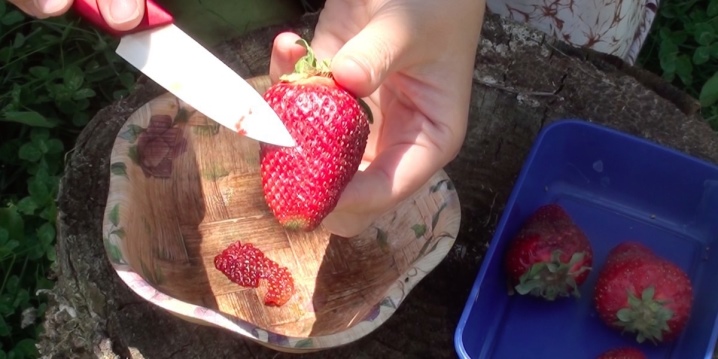
Of the modern methods for isolating seeds, the option with a blender is also known: berries are poured with water, crushed. Those seeds that have sunk to the bottom must be taken out, washed, dried and, of course, prepared for sowing.
Naturally, not everyone wants to bother with such a collection, then they will have to go to the store for seeds.

Seed sowing dates
This process is individual, you need to look at specific regional conditions. If strawberries are planted in the south, then you can do this at the beginning of March, if in the middle lane, the optimal time will be mid-February. And if home planting is planned in the Urals, in Siberia, in the north-west of the country, it will be necessary to sow in early February. Seedlings will sprout for 2-3 months. But this is taking into account that all conditions for growth will be met. For example, without organizing a long day for strawberries, results cannot be achieved (and the day should be 14 hours).
If you postpone sowing until April, the bushes will only yield for the next season. But on the other hand, you can count on the fact that it will be abundant. To grow strawberries in a greenhouse, you will have to sow seeds in an apartment on a windowsill all year round.
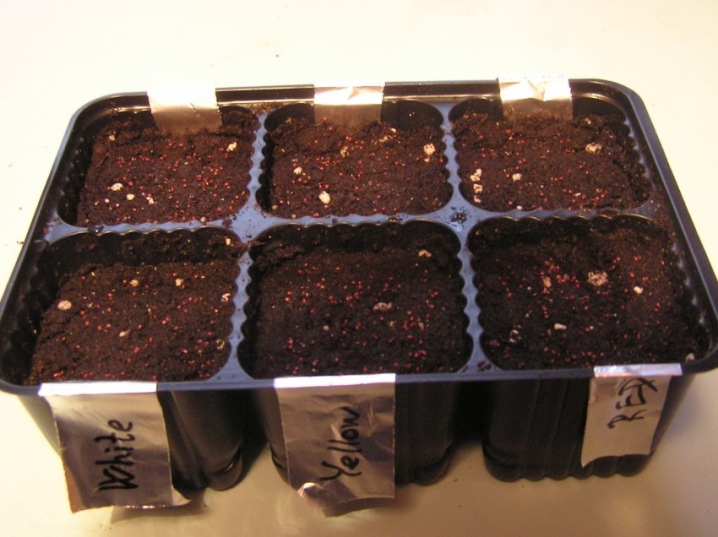
Tank and soil preparation
The easiest way is to buy a ready-made soil mixture, the composition of which is specially selected, fertilized and ready to accept strawberry seedlings. But experienced gardeners believe that everything is not so simple here. And they prefer to prepare the substrate on their own.
What you can't do is plant seedlings in the ground that had grown raspberries, nightshades, and, oddly enough, strawberries in the previous season.
Substrate requirements - light, crumbly and not initially fertilized... This can be, for example, a mixture of sand and forest land, taken in equal proportions. And also you can take 3 parts of vermicompost, sand and peat. Or, for example, combine 2 parts of turf with 1 part of sand and peat. Vermicompost is easy to find in a specialized store, and peat must be deoxidized with dolomite flour (as an option, lime) before use.
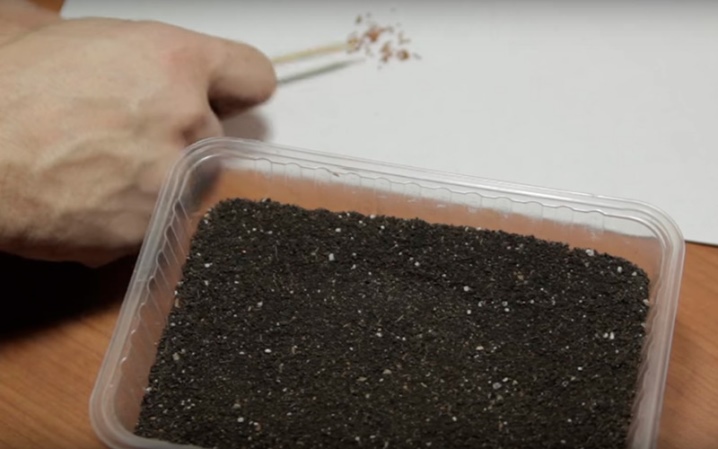
An obligatory stage of soil preparation is the destruction of pests. To do this, the soil can be kept in the oven at a temperature of 200 degrees for 20 minutes. If you do not want to deal with high temperatures, there is another option: freeze the soil by sending a container with it outside. Warming up, after all, also requires subsequent cooling, the earth will have to be sent cool for 2 weeks. And this time will be spent on seed stratification.

Now let's look at how to choose the right container for seedlings.
- Plastic cassettes. They are easy to find in a store that sells everything for gardeners. Only one seed can be placed in each container. Drainage holes in such cassettes have already been made, the buyer will only have to find a pallet.
- Boxes made of boards (homemade). These are reusable containers that will last more than one five years. But every time after use and before a new "call" they have to be disinfected.
- Peat pots. Another popular and affordable option. They are planted in the ground directly with the seedlings, which is very convenient. But, alas, you can often buy an unsuccessful, low-quality option, an outright fake. Therefore, if we take it, then in stores with a good reputation.
- Paper / plastic cups. It is very easy to transplant seedlings from them, but containers will be required for transportation.
- Colorless packaging for cookies, cakes and other. They also have drainage holes. And another big plus is that such packages are usually equipped with lids.
Before filling it with soil, any container should be wiped with a cloth soaked in a solution of potassium permanganate.
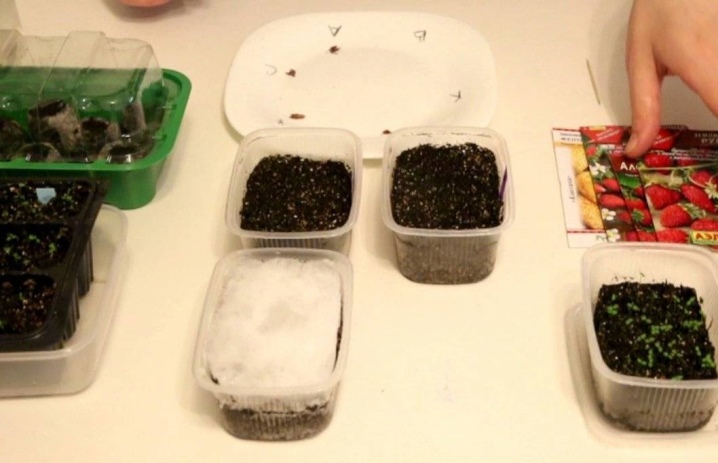
How to plant correctly?
The containers, already filled with the prepared soil mixture, are almost ready for planting seeds. The soil needs to be compacted a little, watered. Then small grooves are made in it, into which the seeds are laid out.
And it is not necessary to cover the seeds with soil after planting, this negatively affects germination.

Further procedure.
- Moisten the ground a little, cover each container with a transparent lid... Instead of a lid, you can take glass or film.
- Condensation will appear on the lid. If there is a lot of it, the containers should be ventilated, if there is none at all, the earth is watered from a spray bottle.
- The place where the seedlings are planted should be well lit and warm. But plants need to be protected from direct sunlight.
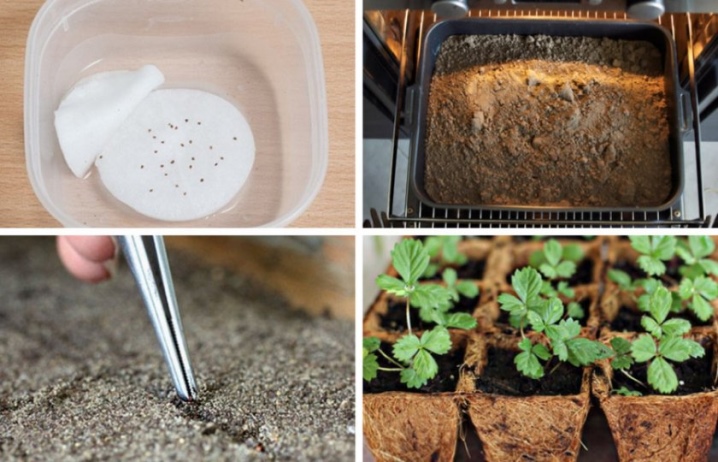
Seed stratification with snow is a great way to advance in successful seed germination. You need to fill the box with earth about 2/3, and then cover it with a dense layer of snow. It needs to be trampled down a little. Soaked seeds are laid out on the surface, the box is sent to the refrigerator for 15 days. The seeds are well watered with melting snow, thanks to this they are drawn into the ground.
After that, the containers are transferred to a warm place, the care becomes traditional.
If the gardener has already managed to prepare cups for individual seating, everything is done the same way, only with the calculation of 1 seed per 1 container. Experts advise planting germinated seeds in separate containers, which give the best germination percentage.

Further care
Strawberry seedlings love warmth, therefore, for the first week and a half of cultivation, you need to maintain the temperature at + 21 ... 23 degrees, do not lower it below these marks. Then it is already possible to reduce it to +18 degrees, the seedlings will undergo such a decrease. But if the temperature, on the contrary, is above normal, the sprouts will stretch out significantly and, alas, weaken. Natural light for 14-hour daylight hours, of course, is not enough. Therefore, the window sills are equipped with ultraviolet lamps.
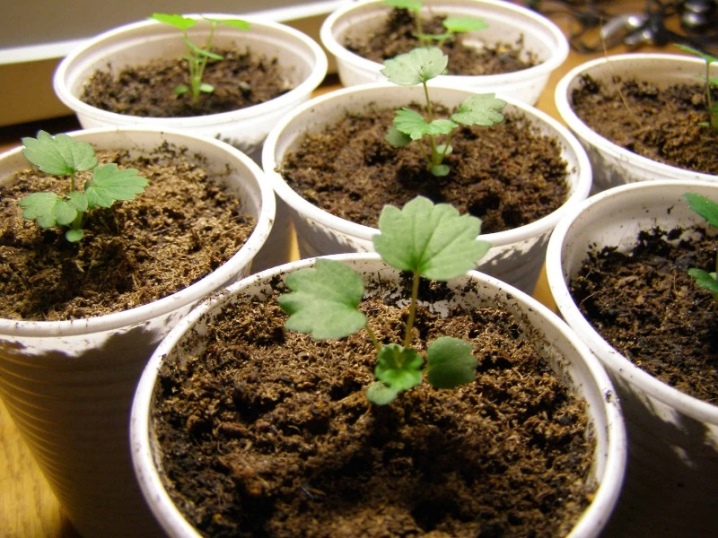
Watering
The sprouts will not tolerate droughts, but excessive watering is contraindicated for them. Therefore, an optimal irrigation regime is required, the so-called golden mean. Ideally, the substrate should always be damp; it simply cannot be allowed to dry out. Watering is carried out in the morning, you need to pour water at the root.
Water should not fall on the leaves. It is advisable to use settled and heated water for irrigation.
It is most convenient to water the seedlings from a pipette or syringe without a needle. Melt water is always preferable to tap water.
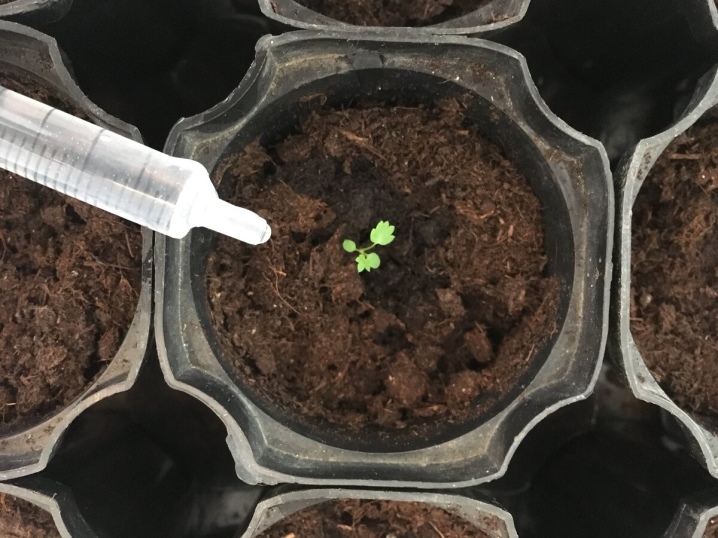
Picking
If the berries are planted in a common container, the seedlings will have to be transplanted into separate containers. It is necessary to dive a strawberry only after it has 3 real leaves. And this happens not earlier than 3 weeks after sowing, or even after all 6 weeks.

Let's analyze the features of the pick.
- In order not to harm the roots of the seedlings, special devices are used, for example, juice tubes.
- 30 minutes before the pick, the seedlings are watered with water with the HB-101 stimulator (in a proportion of 0.5 liters of water per 1 drop of the agent). This will make the transplant process easier.
- Soil pots are prepared in advance. The soil mixture is used the same as for seeds. The soil in the pot must be watered, a hole is made in it. The sprouts from the soil are taken as accurately as possible, it is better to capture the sparse ones with an earthen lump. But if the sprouts are thickened, you need to pull out several at once and divide, releasing the roots, and they, in turn, need to be washed.
- Seedlings are sent to the holes, the roots must be straightened before planting the plant, otherwise they may bend up. Long roots can also be shortened.
- Sprinkle the transplanted plant with soil, compact. With dry soil, you can irrigate it with one teaspoon of water using the same growth stimulant. And then the pots are sent to the greenhouse, covered with a transparent lid. They are placed in a box, which in turn is placed in a plastic bag.
For seedlings, choose a bright place, but not in direct sunlight.
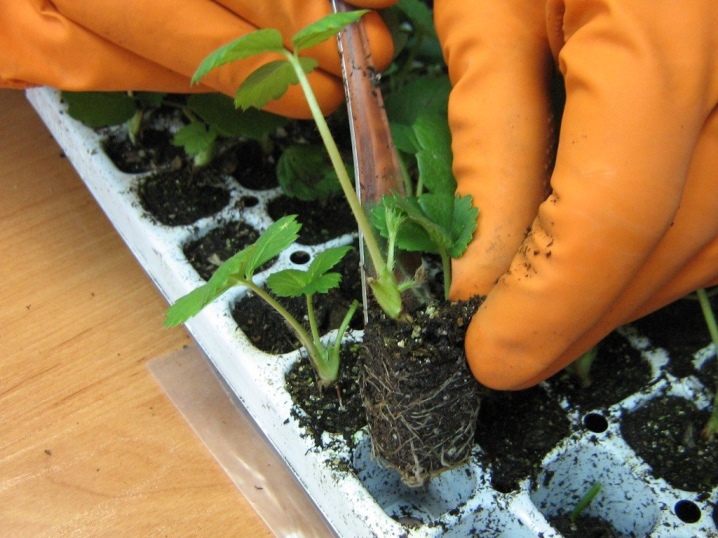
Top dressing
The soil under the strawberries, while the seeds are sprouting, is depleted rather quickly. The plant instantly snatches nutrients from it.
The first feeding falls on the period when 2-3 true leaves appeared on the sprout.
Seedlings from common containers will be fed on the fifth day after the pick. Then fertilizers will be applied once every 1.5 weeks. Complex mineral fertilizers are used for this purpose, for example, nitrophoska. "Fertika", "Solution" are also suitable.
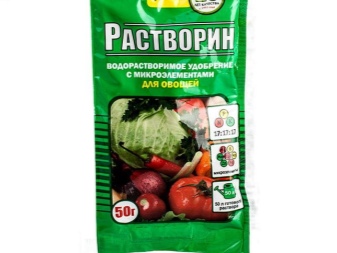
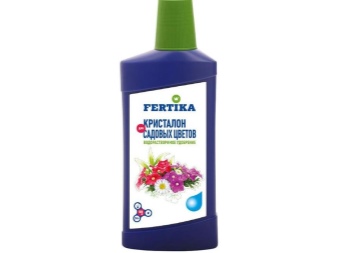
Useful Tips
This paragraph contains important recommendations that will be especially useful for debutants, those who first decided to start growing strawberries from seeds.
- Everyone wants to count on the harvest in the first year, but you need to be far-sighted. There is no need to rush. For seedlings that have been planted in a permanent place, it is better to cut off the flower stalks in the summer. The bushes will only gain strength from this, and next year the harvest will be outstanding.
- The seedlings are vulnerable to pests, the first of which is the spider mite. You can get rid of it with acaricidal agents.
- Picking is an important procedure, but not always there is a 100% need for it. If the sprouts in a common container do not interfere with each other, then there is no need to disturb them. The transplant, unfortunately, is often associated with the death of seedlings.
- Milk and juice cartons - unwanted containers for growing strawberry seeds... They have a special film layer that is undesirable for the microclimate and air exchange in the container. The seedlings that grow there develop much worse than in the same peat (and even plastic) pot.
- You should not rush to open the grown seedlings. At first, it is enough to move the lid a little, then open it for a short time, gradually increasing the opening time. Plants must calmly adapt to their environment.
- If you overdo it with watering, the plant can react to this with the appearance of such an undesirable phenomenon as a black leg. If it is found, the seedlings must be immediately transferred to another, healthy soil. When watering, a fungicide must be added.
- If it is indoor strawberries that are grown, you need to pick up pots for her with a volume of 3 liters and a height of about 15 cm.
- The hardening of seedlings, which is necessary before planting in the ground, should be smooth. First, the plants are taken out on the veranda or in the greenhouse for 15 minutes, no more. The time increases gradually and reaches several hours.
- It is recommended to transplant strawberries into street soil during the period when the soil has warmed up to +15 degrees.
- If the first leaves on the seedlings began to turn yellow, this is a clear sign that watering should be reduced. But in general, yellow plants indicate that sunburn also threatens them. Strawberries should be shaded.
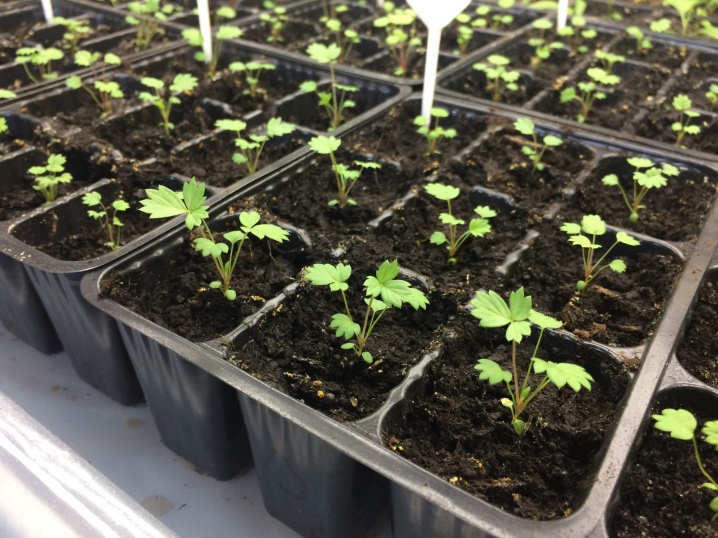
And, of course, old seeds should not be used for berry propagation. This is a risk that is rarely justified.
Successful garden experiments!
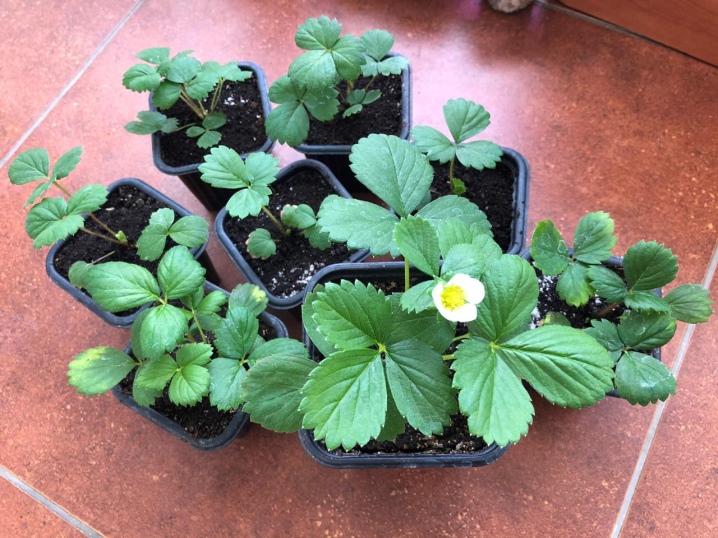













The comment was sent successfully.